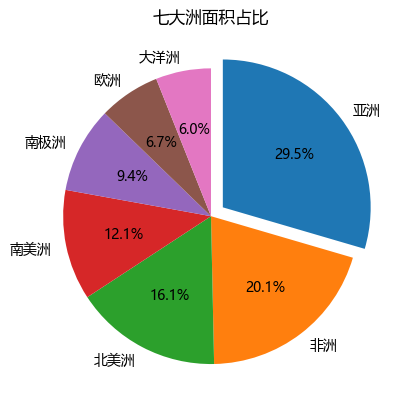写在前面
最近,开始对于CMIP6的一些数据进行评估。Talor图是一个很好展现模式间误差的方式,这里简单记录一下在python中的实现方式。
- 主要为半图的画法
参考的代码为:
- https://zenodo.org/records/5548061
效果大致下面这个样子

这边在原本代码基础上,主要是设置了三个坐标label的颜色以及内部网格线的颜色的区别。
其中,绿色弧线表示RMSE,黑色弧线表示STD,蓝色网格线表示相关系数correlation
修改
这里,原本的代码中std和correlation的网格线是相同的颜色,我这里强行为了将去区分开,相当于自己强行叠加了一层std的弧线,使其看起来是黑色,实际上他原本还是蓝色。
实现的代码是这样:
- 里面的rlocs就是控制绘制std网格线的具体数值,可以根据自己的数据进行适当的修改
def add_grid(self,stdcolor,corrcolor, *args, **kwargs):
grid = self._ax.grid(color=corrcolor,*args, **kwargs)
"""Add a grid."""
rlocs = np.arange(0,90,10) # 生成多个标准差值,可以根据需要进行更改
for r in rlocs:
print(r)
circle = plt.Circle((0, 0), r, transform=self._ax.transData._b, color=stdcolor,
fill=False, linestyle='-',linewidth=1.5,zorder=2)
self._ax.add_patch(circle)
return grid
代码解释
- 下面简答讲一下这个代码的主函数
def test1():
"""Display a Taylor diagram in a separate axis."""
# Reference std
stdref = 48.491
# Samples std,rho,name
samples = [[25.939, 0.3, "Model A"],
[29.593, 0.5, "Model B"],
[33.125, 0.6, "Model C"],
[29.593, 0.7, "Model D"],
[71.215, 0.473, "Model E"],
[27.062, 0.360, "Model F"],
[38.449, 0.342, "Model G"],
[35.807, 0.609, "Model H"],
[17.831, 0.360, "Model I"]]
refstd = stdref
fig = plt.figure(figsize=(12, 6),dpi=200)
# Taylor diagram
dia = TaylorDiagram(refstd, fig=fig, rect=111, label="Obs",
srange=(0., 1.8))
colors = cmaps.matlab_jet(np.linspace(0, 1, len(samples)))
# Add the models to Taylor diagram
for i, model in enumerate(samples):
print(i,model)
marker_color = colors[i]
label_color = 'black' # Set legend label color to black
dia.add_sample(samples[i][0], samples[i][1],
marker='$%d$' % (i+1),
ms=8, ls='',
mfc=marker_color, mec=marker_color,
label=f"{samples[i][2]}", color=label_color) # Specify label color here
# # Add grid
dia.add_grid(stdcolor='k',corrcolor='blue',linestyle='-.')
# # Add RMS contours, and label them
contours = dia.add_contours(linestyle='--',color='green')
plt.clabel(contours, inline=1, fontsize=10, fmt='%.2f')
# # Add a figure legend
legend = fig.legend(dia.samplePoints,
[p.get_label() for p in dia.samplePoints],
numpoints=1, prop={'size': 'small'}, ncol=2,
loc='upper right', frameon=False, bbox_to_anchor=(0.9, 0.7))
plt.setp(legend.texts, color='black')
plt.show()
# save_figure(fig,'taylor diagram of cmip6 model')
return dia
dia = test1()
stdref = 48.491
这个主要是一个参考的数值,可以将其是为观测真值的标准差的数值
samples = [[25.939, 0.3, "Model A"],
[29.593, 0.5, "Model B"],
[33.125, 0.6, "Model C"],
[29.593, 0.7, "Model D"],
[71.215, 0.473, "Model E"],
[27.062, 0.360, "Model F"],
[38.449, 0.342, "Model G"],
[35.807, 0.609, "Model H"],
[17.831, 0.360, "Model I"]]

要绘制这样的泰勒图呢,需要提供一个列表或者数组或者字典,如示例中的;
第一列是std,第二列是correlation,第三列是model的名称;放在代码里面如下所示,这几个数据是绘制泰勒图必要的参数。
其中,rmse不需要传递,他会自己根据你提供的std数据进行计算。
泰勒图可以其理解为由std和correlation的极坐标系,类似于我们普通绘制x-y的散度图。
知道了需要传递的数据类型,下面绘制数据的部分就容易很多了
for i, model in enumerate(samples):
print(i,model)
marker_color = colors[i]
label_color = 'black' # Set legend label color to black
dia.add_sample(samples[i][0], samples[i][1],
marker='$%d$' % (i+1),
ms=8, ls='',
mfc=marker_color, mec=marker_color,
label=f"{samples[i][2]}", color=label_color) # Specify label color here
# # Add grid
dia.add_grid(stdcolor='k',corrcolor='blue',linestyle='-.')
# # Add RMS contours, and label them
contours = dia.add_contours(linestyle='--',color='green')
plt.clabel(contours, inline=1, fontsize=10, fmt='%.2f')
# # Add a figure legend
legend = fig.legend(dia.samplePoints,
[p.get_label() for p in dia.samplePoints],
numpoints=1, prop={'size': 'small'}, ncol=2,
loc='upper right', frameon=False, bbox_to_anchor=(0.9, 0.7))
对于你提供的数据,循环传递,类似于绘制散度的形式,通过定义的dia类通过add_sample()函数进行传入,
add_sample(self, stddev, corrcoef, *args, **kwargs)
第一个为标准偏差std;第二个参数为相关系数corr;marker为显示的legend的编号类型,可以是数字,五角星,三角形,可以自由修改;
label是定义的model的名称,可以是model-1,model-2,或者说具体各个model的名称
dia.add_grid(stdcolor='k',corrcolor='blue',linestyle='-.')
添加泰勒图的网格线,这里提供两个参数,可以自定义修改std和corr的颜色
contours = dia.add_contours()
添加rmse的弧线,可以自定义线的类型,颜色等
legend = fig.legend(dia.samplePoints, [p.get_label() for p in dia.samplePoints], numpoints=1, prop={'size': 'small'}, ncol=2, loc='upper right', frameon=False, bbox_to_anchor=(0.9, 0.7))
设置了legend的摆放位置,可以自定义通过bbox_to_anchor进行微调
全部代码
- 理论上,只需要替换sample的数据为自己的数据,就可以得到相应的绘制结果
# -*- coding: utf-8 -*-
"""
Created on %(date)s
@author: jianpu
@email : xianpuji@hhu.edu.cn
"""
import matplotlib.ticker as ticker
import xarray as xr
import matplotlib.pyplot as plt
import numpy as np
from matplotlib import colors
import pandas as pd
from matplotlib import gridspec
from matplotlib.colors import ListedColormap
import matplotlib.cm as cm
import matplotlib.colors as mcolors
import os
import glob
from datetime import datetime, timedelta
import cmaps
from cartopy.mpl.ticker import LongitudeFormatter, LatitudeFormatter
import cftime
import cartopy.crs as ccrs
import cartopy.feature as cfeature
import matplotlib.patches as patches
plt.rcParams['font.family'] = 'Times New Roman'
plt.rcParams['font.size'] = 14
def save_figure(fig,filename='meridional_mean'):
fnFIG = os.path.splitext(os.path.basename(__file__))[0]
outfolder = fnFIG
if not os.path.exists(outfolder):
os.makedirs(outfolder)
print(f'{outfolder} has been created')
else:
print(f'{outfolder} already exists')
outpath = os.path.join(outfolder, filename)
fig.savefig(outpath, dpi=300, bbox_inches='tight')
class TaylorDiagram(object):
"""
Taylor diagram.
Plot model standard deviation and correlation to reference (data)
sample in a single-quadrant polar plot, with r=stddev and
theta=arccos(correlation).
"""
def __init__(self, refstd,
fig=None, rect=111, label='_', srange=(0, 1.5), extend=False,
xlabel='Obs'):
"""
Set up Taylor diagram axes, i.e. single quadrant polar
plot, using `mpl_toolkits.axisartist.floating_axes`.
Parameters:
* refstd: reference standard deviation to be compared to
* fig: input Figure or None
* rect: subplot definition
* label: reference label
* srange: stddev axis extension, in units of *refstd*
* extend: extend diagram to negative correlations
"""
from matplotlib.projections import PolarAxes
import mpl_toolkits.axisartist.floating_axes as FA
import mpl_toolkits.axisartist.grid_finder as GF
self.refstd = refstd # Reference standard deviation
tr = PolarAxes.PolarTransform()
# Correlation labels
rlocs = np.array([0, 0.2, 0.4, 0.6, 0.7, 0.8, 0.9, 0.95, 0.99, 1])
if extend:
# Diagram extended to negative correlations
self.tmax = np.pi
rlocs = np.concatenate((-rlocs[:0:-1], rlocs))
else:
# Diagram limited to positive correlations
self.tmax = np.pi/2
tlocs = np.arccos(rlocs) # Conversion to polar angles
gl1 = GF.FixedLocator(tlocs) # Positions
tf1 = GF.DictFormatter(dict(zip(tlocs, map(str, rlocs))))
# Standard deviation axis extent (in units of reference stddev)
self.smin = srange[0] * self.refstd
self.smax = srange[1] * self.refstd
ghelper = FA.GridHelperCurveLinear(
tr,
extremes=(0, self.tmax, self.smin, self.smax),
grid_locator1=gl1, tick_formatter1=tf1)
if fig is None:
fig = plt.figure()
ax = FA.FloatingSubplot(fig, rect, grid_helper=ghelper)
fig.add_subplot(ax)
# Adjust axes
ax.axis["right"].major_ticklabels.set_fontsize(18)
ax.axis["left"].major_ticklabels.set_fontsize(18)
ax.axis["top"].major_ticklabels.set_fontsize(18)
ax.axis["top"].set_axis_direction("bottom") # "Angle axis"
ax.axis["top"].toggle(ticklabels=True, label=True)
ax.axis["right"].toggle(ticklabels=True, label=True)
ax.axis["top"].major_ticklabels.set_axis_direction("top")
ax.axis["top"].label.set_axis_direction("top")
ax.axis["left"].set_axis_direction("bottom") # "X axis"
ax.axis["right"].label.set_fontsize(22)
ax.axis["right"].label.set_weight('bold')
ax.axis["left"].label.set_fontsize(22)
ax.axis["left"].label.set_weight('bold')
ax.axis["top"].label.set_fontsize(22)
ax.axis["top"].label.set_weight('bold')
ax.axis["left"].label.set_color('red')
ax.axis["right"].label.set_color('k')
ax.axis["top"].label.set_color('b')
ax.axis["left"].label.set_text("Observation")
ax.axis["right"].label.set_text("Standard deviation")
ax.axis["top"].label.set_text("Correlation")
ax.axis["left"].line.set_linewidth(2)
ax.axis["top"].line.set_linewidth(2)
ax.axis["right"].line.set_linewidth(2)
ax.axis["right"].set_axis_direction("top") # "Y-axis"
ax.axis["right"].toggle(ticklabels=True)
ax.axis["right"].major_ticklabels.set_axis_direction(
"bottom" if extend else "left")
if self.smin:
ax.axis["bottom"].toggle(ticklabels=False, label=False)
else:
ax.axis["bottom"].set_visible(False) # Unused
self._ax = ax # Graphical axes
self.ax = ax.get_aux_axes(tr) # Polar coordinates
# Add reference point and stddev contour
l, = self.ax.plot([0], self.refstd, 'r*',
ls='', ms=10, label=label)
t = np.linspace(0, self.tmax)
r = np.zeros_like(t) + self.refstd
self.ax.plot(t, r, 'r--', label='_')
# Collect sample points for latter use (e.g. legend)
self.samplePoints = [l]
def draw_outer_border(self, ax):
"""
Draw an outer border around the polar plot.
"""
# Create a circle patch
outer_border = patches.Circle(
(0, 0), self.smax,
transform=ax.transData._b, # Use the polar transformation
color='black', linewidth=2, fill=False, linestyle='--'
)
# Add the patch to the plot
ax.add_patch(outer_border)
def add_sample(self, stddev, corrcoef, *args, **kwargs):
"""
Add sample (*stddev*, *corrcoeff*) to the Taylor
diagram. *args* and *kwargs* are directly propagated to the
`Figure.plot` command.
"""
l, = self.ax.plot(np.arccos(corrcoef), stddev,
*args, **kwargs) # (theta, radius)
self.samplePoints.append(l)
return l
def add_grid(self,stdcolor,corrcolor, *args, **kwargs):
grid = self._ax.grid(color=corrcolor,*args, **kwargs)
"""Add a grid."""
rlocs = np.arange(0,90,10) # 生成多个标准差值,可以根据需要进行更改
for r in rlocs:
print(r)
circle = plt.Circle((0, 0), r, transform=self._ax.transData._b, color=stdcolor,
fill=False, linestyle='-',linewidth=1.5,zorder=2)
self._ax.add_patch(circle)
return grid
def add_contours(self, levels=5, **kwargs):
"""
Add constant centered RMS difference contours, defined by *levels*.
"""
rs, ts = np.meshgrid(np.linspace(self.smin, self.smax),
np.linspace(0, self.tmax))
# Compute centered RMS difference
rms = np.sqrt(self.refstd**2 + rs**2 - 2*self.refstd*rs*np.cos(ts))
contours = self.ax.contour(ts, rs, rms, levels,colors='green', linestyles='--', **kwargs)
return contours
def test1():
"""Display a Taylor diagram in a separate axis."""
# Reference std
stdref = 48.491
# Samples std,rho,name
samples = [[25.939, 0.3, "Model A"],
[29.593, 0.5, "Model B"],
[33.125, 0.6, "Model C"],
[29.593, 0.7, "Model D"],
[71.215, 0.473, "Model E"],
[27.062, 0.360, "Model F"],
[38.449, 0.342, "Model G"],
[35.807, 0.609, "Model H"],
[17.831, 0.360, "Model I"]]
refstd = stdref
fig = plt.figure(figsize=(12, 6),dpi=200)
# Taylor diagram
dia = TaylorDiagram(refstd, fig=fig, rect=111, label="Obs",
srange=(0., 1.8))
colors = cmaps.matlab_jet(np.linspace(0, 1, len(samples)))
# Add the models to Taylor diagram
for i, model in enumerate(samples):
print(i,model)
marker_color = colors[i]
label_color = 'black' # Set legend label color to black
dia.add_sample(samples[i][0], samples[i][1],
marker='*',
ms=8, ls='',
mec=marker_color,
label=f"{samples[i][2]}", color=label_color) # Specify label color here
# # Add grid
dia.add_grid(stdcolor='k',corrcolor='blue',linestyle='-.')
# # Add RMS contours, and label them
contours = dia.add_contours()
plt.clabel(contours, inline=1, fontsize=10, fmt='%.2f')
# # Add a figure legend
legend = fig.legend(dia.samplePoints,
[p.get_label() for p in dia.samplePoints],
numpoints=1, prop={'size': 'small'}, ncol=2,
loc='upper right', frameon=False, bbox_to_anchor=(0.9, 0.7))
plt.setp(legend.texts, color='black')
plt.show()
save_figure(fig,'taylor diagram of cmip6 model')
return dia
dia = test1()



















